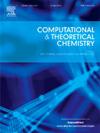Deciphering the mechanism and selectivities of the reactions of mesitonitrile oxide with 1,5-Dimethyl-6-methylenetricyclo[3.2.1.02,7]oct-3-en-8-one Derivatives: A computational approach
IF 3
3区 化学
Q3 CHEMISTRY, PHYSICAL
引用次数: 0
Abstract
Isoxazoline and spirocyclic compounds have been recognized for their notable biological significance in various studies. The preferential selectivities and underlining molecular reaction path for the [3 + 2] cycloaddition reactions of mesitonitrile oxide with 1,5-dimethyl-6-methylenetricyclo[3.2.1.02,7]oct-3-en-8-one derivatives have been investigated by employing the hybrid B3LYP/6-311G (d, p) density functional theory. The reaction between mesitonitrile oxide and 1,5,8-trimethyl-6-methylenetricyclo[3.2.1.02,7]oct-3-en-8-endo-ol site- and regioselectively proceed by adding across the endocyclic site of the 1,5,8-trimethyl-6-methylenetricyclo[3.2.1.02,7]oct-3-en-8-endo-ol. The computed global electron density transfer results predict a low polar process for the mechanism. Analysis from the intrinsic reaction coordinates also confirms the obtained stationary points’ geometries and energies. The global reactivity indices analysis shows that the mesitonitrile oxide behaves as an electrophile in all the reactions. The calculated local reactivity indices align with the energetic trends and the experimentally observed site- and regioselectivity of the [3 + 2] cycloaddition reaction.

求助全文
约1分钟内获得全文
求助全文
来源期刊

Computational and Theoretical Chemistry
CHEMISTRY, PHYSICAL-
CiteScore
4.20
自引率
10.70%
发文量
331
审稿时长
31 days
期刊介绍:
Computational and Theoretical Chemistry publishes high quality, original reports of significance in computational and theoretical chemistry including those that deal with problems of structure, properties, energetics, weak interactions, reaction mechanisms, catalysis, and reaction rates involving atoms, molecules, clusters, surfaces, and bulk matter.
 求助内容:
求助内容: 应助结果提醒方式:
应助结果提醒方式:


